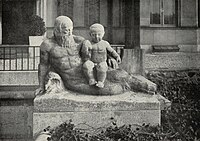Ludwig Nick
Ludwig Nick (Münster, 30 January 1873 – Jena, July 1936) was a German sculptor and art professor, who worked in stone, bronze, wood and porcelain.[1][2]
Life and work
[edit]Nick was practically educated in stone and wood sculpting by Heinrich Fleige (1840–1890) in Münster, and he visited the local Kunst- und Gewerbeschule.[1][3] After practising his profession for several years, he started a six-year study at the Königliche akademische Hochschule für die bildenden Künste in Berlin, receiving master classes from Peter Breuer and Ernst Herter.[2]
In 1905 – perhaps earlier also, and certainly several times more in the next decades – Nick was an attendee of the Große Berliner Kunstausstellung, a joint annual exposition of the Akademie and the Verein Berliner Künstler (Union of Berlin Artists).[4] He showed a marble piece called 'Verlassen' ('Abandoned'), which was then bought by the German Emperor Wilhelm II.[5] In 1908, Nick won a one-year travel scholarship from the Paul Schultze-Stiftung,[6] better known as the Rom-Preis (Rome Award) of the Preußische Akademie der Künste.[3] This meant he could reside 1908–1909 in Villa Strohl Fern in Rome.[7] After the stay he started to work at the Berlin Akademie.[2]

In the years before World War I, Nick was the favorite collaborator of architect Edmund Körner, Nick's fellow student in Berlin.[8] Körner, based in Essen and famous for his design of the Old Synagogue there, commissioned Nick for stone sculpture jewelry for public and private buildings, for a marmor fireplace and bronze statues for the court state Dippelshof in Darmstadt, and also for the giant nail man Schmied von Essen.[9][10][8][2]
Meanwhile, he made other works too, among which funerary monuments in Berlin.[2] Nick's only known public work outside Germany can be found in the Dutch city of Enschede, not far from Münster: in 1912 he was commissioned to create a monument in memory of the fire that fifty years earlier had burned down the town;[11] in the same year, Nick created sculptures of Gerrit Jan van Heek (1837-1915), a textile manufacturer from Enschede, and his second wife Christine Friederike Van Heek-Meier (1842-1920), the parents of Jan Herman van Heek.[12]
After the war had ended, in 1918, Nick created many war memorials, among other in Berlin-Schmargendorf. In 1924 he sculpted the stone lion for the Löwendenkmal, the warrior memorial for Leipzig University, a monument designed by August Gaul, who had died before finishing it. In 1925 he made a wooden epitaph for the members of the Berliner Liedertafel that fell in World War I.[2]
In 1920 Walter Gropius' Bauhaus in Weimar was looking for a master craftsman for stone carving and gypsum foundry. The sculptor Richard Engelmann, professor at the Großherzoglich Sächsische Hochschule für Bildende Kunst, the older art school in Weimar, asked Gaul for a candidate, and Gaul recommended Nick. Gropius however declined the appointment, saying that there was "künstlerischer Ehrgeiz", artistic ambition, in Nick's work and that he looked more for a stonemason.[13]

Nick worked freelance for Meissen porcelain from about 1927 to 1930 – the factory acquired several of his models.[2][14] Among his Meissen works are Hirte (1929), Rübezahl (1930), Mutter mit Kind (1930) and other figurines, that often came in cheaper white and more expensive colored, sometimes gold decorated versions.[2] His porcelain work was praised for its stylistic unity and pronounced main view.[2] He designed the firm's new year plaque for 1929.
In 1930 he received the sculptor price of the Verein Berliner Künstler.[15] The same year the City of Berlin purchased Nick's Madonna, a piece that was on display at the Verein's autumn exposition.[16]
In Weimar in 1930, the architect, critic and NSDAP member Paul Schultze-Naumburg on the initiative of Wilhelm Frick got in charge of the Weimar Hochschule.[13] He set up a section for crafts and sculpture (it was in fact a private school, separate from the Hochschule) in Gropius' Bauhaus building in Dessau.[13] Engelmann had been fired and Schultze Naumburg didn't want him to return, he had Nick leading the section.[13] Engelmann's work lacked the Heimat expression and the steel, folk element as they were perceived or wanted in that time, while Nick's figures looked incomparably slimmer and more sinewy, therefor corresponding more to the new ideal.[13]
After the Gleichschaltung of 1933, Nick became head of the workshop for stone and wood carving in Weimar. He became a member of the Deutscher Werkbund in 1934, and he would keep his position until his death in 1936.[17][18] Among Nick's students was Jan Holschuh.[19]
In the year of his death he created the chain of office for the mayor of Eisenach and in Gerstungen he finished his Storchenbrunnen.[2][20]
Some works
[edit]
- Brandmonument (1912), the "Fire monument" in Enschede, commemorating the city fire of 7 May 1862 that destroyed the entire inner city, ended the lives of two women and left 3675 inhabitants roofless.[21] The 5 meter high monument is made of grey sandstone, carrying bronze plates and the city's coat of arms at the sides and a sculpture of a female figure with a horn of plenty on top, and it has two side basins for the water that comes from lion heads.[22]
- Schmied von Essen (1915), "Blacksmith of Essen", a 3.5 meter high nail man relief, an oak wood triptych housed in a white, temple-like pavilion designed by Körner that was built on the forecourt of Essen Hauptbahnhof. The central figure, the 'iron man' standing before an Iron Cross, held a sword and a shield with the Reichsadler; next to his head were the words Gott mit uns, lying at the feet a 8-headed Hydra, its heads symbolizing the enemies of Germany; the side panels held two quotes from Wilhelm II.[23][8] Only forged and galvanized iron nails were used for the nailing of the apron, the sword and the shield.[24] The pavilion was dismantled in 1918, the year the Emperor abdicated, and after the central figure had been restored it was re-erected in the city park StadtGarten Essen, before being moved to the Grugapark in 1934, where it was lost during a bombardment in World War II.[25]
- Löwendenkmal der Universität Leipzig (1924), a monument baring the names of 1396 students and employees that have fallen in World War I. Designed by Gaul, the memorial was finished by his student Max Esser, while Nick was commissioned to sculpt the lion.[26][27]
- Two sandstone figures (1935), personifications of the "Nährstand" (farmers class) and the "Wehrstand" (nobility class), on the stepped gables of a bank building by Schultze-Naumburg in Parchim.[28]
- Storchenbrunnen (1934–36), "Stork well" in Gerstungen, an octagonal Muschelkalk fountain with animal figurines decorating a four spouts central water inlet that is topped by a slender limestone column carrying a roughly life-size bronze stork, the heraldic charge of the community.[29]
- Chain of office for the mayor of Eisenach (1936). In 1945 the National Socialist symbols were removed from the chain.[2][20]
Gallery
[edit]-
Brandmonument (1912), Enschede
-
Detail of the Brandmonument
-
Fountain figure (c. 1912), Essen
-
Fountain figure (c. 1912), Essen
-
Schmied von Essen (1915), Essen
-
Pavilion of the Schmied von Essen
-
"Lion memorial" (1924), Leipzig
-
Storchenbrunnen (1936), Gerstungen
References
[edit]- ^ a b "Volksgemeinschaft: Heidelberger Beobachter, NS-Zeitung für Nordbaden". Universitätsbibliothek Heidelberg. 16 July 1936. Retrieved 14 October 2020. This newspaper says Nick died in Jena, a town about 20 kilometers from Weimar. The short obituary also is the only found source, so far, mentioning Nick's teacher in Münster, Fleige (misspelled as "Feige"), which appears to be credible and likely. A Dutch newspaper seems to have copied the message: "Het Vaderland, staat- en letterkundig nieuwsblad". Delpher. 18 July 1936. Retrieved 13 October 2020. A second German newspaper also gives Jena as the place of death, although the statement may also be a, shortened, copy of the first: "Heidelberger neueste Nachrichten: Heidelberger Anzeiger". Universitätsbibliothek Heidelberg. 20 July 1936. Retrieved 14 October 2020.
- ^ a b c d e f g h i j k Staps, Sven-Wieland (2020). "Nick, Ludwig". Allgemeines Künstlerlexikon. De Gruyter. Retrieved 12 October 2020. Note that while the 1936 sources state that Nick died in Jena, Allgemeines Künstlerlexikon has Weimar as his place of death, and gives 8 August as the date of death, while the newspaper obituaries appear from 16 July on.
- ^ a b "Chronik der Königlichen Akademie der Künste zu Berlin — 1908". Universitätsbibliothek Heidelberg. 1908. Retrieved 13 October 2020.
- ^ See the attendee lists of 1905, 1907, 1919, 1920, 1921 and 1924.
- ^ "Die Werkstatt der Kunst: Organ für d. Interessen d. bildenden Künstler". Universitätsbibliothek Heidelberg. 1905. Retrieved 15 October 2020.
- ^ Statuten der Dr. Paul Schultze-Stiftung, Berlin 1895
- ^ "Preußische Akademie der Künste". Akademie der Künste Archiv. Retrieved 14 October 2020.
- ^ a b c Barbara Pankoke, Der Essener Architekt Edmund Körner (1874–1940). Leben und Werk, VDG Weimar – Verlag und Datenbank für Geisteswissenschaften, 1996.
- ^ "Moderne Bauformen: Monatshefte für Architektur und Raumkunst". Universitätsbibliothek Heidelberg. 1914. Retrieved 16 October 2020.
- ^ "Moderne Bauformen: Monatshefte für Architektur und Raumkunst". Universitätsbibliothek Heidelberg. 1914. Retrieved 16 October 2020.
- ^ "Tubantia". Delpher. 15 February 1912. Retrieved 15 October 2020.
- ^ Collectie Nederland
- ^ a b c d e Silke Opitz, Ein Gentlemankünstler. Leben und Werk des Bildhauers Richard Engelmann 1868–1966, VDG Weimar, 2000.
- ^ "Meissener® porcelain story". Meissen® Modellnummern Datenbank. Retrieved 13 October 2020.
- ^ "Die Weltkunst — 4.1930". Universitätsbibliothek Heidelberg. 1930. Retrieved 14 October 2020.
- ^ "Die Weltkunst — 4.1930". Universitätsbibliothek Heidelberg. 1930. Retrieved 14 October 2020.
- ^ "Die Form: Zeitschrift für gestaltende Arbeit". Universitätsbibliothek Heidelberg. 1934. Retrieved 17 October 2020.
- ^ Achim Preiss & Klaus-Jürgen Winkler, Weimarer Konzepte. Die Kunst- und Bauhochschule 1860–1995, VDG Weimar, 1996.
- ^ Meyer-Bremen, Rudolf (9 August 2003). "Ursprüngliche Formen. Ribnitz-Damgarten zeigt Arbeiten von Jan Holschuh in Dauerausstellung" (PDF). Preußische Allgemeine Zeitung. Retrieved 13 October 2020.
- ^ a b "Beschaffung einer Amtskette für den Oberbürgermeister". Archivportal Thüringen. Retrieved 13 October 2020.
- ^ "Monument Stadsbrand 7 mei 1862". Stichting Cultureel Erfgoed Enschede. Retrieved 12 October 2020.
- ^ "De arbeid, weekblad van het Nationaal Arbeidssecretariaat in Nederland". Delpher. 21 February 1912. Retrieved 15 October 2020.
- ^ "Kunstchronik: Wochenschrift für Kunst und Kunstgewerbe". Heidelberg historic literature – digitized. 1915. Retrieved 12 October 2020.
- ^ Lasius, Julius (10 February 1916). "Kriegswahrzeichen in rheinisch-westfälischen Industriestädten (in: Stahl und Eisen, Zeitschrift für das Deutsche Eisenhüttenwesen. 36. Jahrgang, Nr.6, pp. 133–137)" (PDF). Digital Library of the Silesian University of Technology. Retrieved 13 October 2020.
- ^ Rieth, Hugo. "Essen in alten Ansichten Band 2". Uitgeverij Europese Bibliotheek. Retrieved 10 October 2020.
- ^ Steindorff, Georg (1925). "August Gauls Kriegerdenkmal: vier Lichtdrucktafeln mit dem Verzeichnis der Gefallenen und dem Berichte der Universitaet ueber die Enthuellungsfeier am 31. Oktober 1924". Paulinerkirche Wiederbebauung Universität Leipzig. Retrieved 13 October 2020.
- ^ Neugebauer, Karl Anton (September 1925). "Ein nachgelassenes Werk von August Gaul". Der Kunstwanderer: Zeitschrift für alte und neue Kunst, für Kunstmarkt und Sammelwesen (Universitätsbibliothek Heidelberg). Retrieved 14 October 2020.
- ^ Hameister, Silke (2017). "Stadtentwicklung und Wohnungsbau in der Stadt Güstrow in vergleichender Betrachtung zur Stadt Parchim in der Zeit von 1871 bis 1990, Teil I: Textband" (PDF). Universität Greifswald. Retrieved 12 October 2020.
Der „Nährstand", die linke Figur, blickt nach Süden und beschattet mit der rechten Hand ihre Augen und hält in der linken eine Saatschale. Der „Wehrstand", die rechte Figur, trägt eine mittelalterliche Rüstung mit dem Parchimer Stier als Wappenzeichen auf dem Schild.
- ^ Schmedding, Karl Heinz (1992). 7. Juni 1936: Einweihung des Gerstunger Storchenbrunnens. Heimatblätter zur Geschichte, Kultur und Kunst. Vol. 2. Marburg: Eisenacher Presse. p. 77. ISBN 3-924269-94-7.








